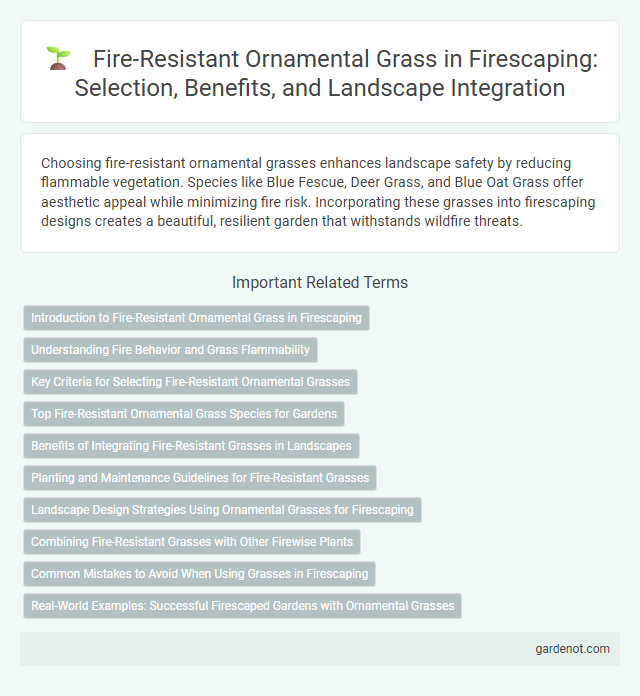Choosing fire-resistant ornamental grasses enhances landscape safety by reducing flammable vegetation. Species like Blue Fescue, Deer Grass, and Blue Oat Grass offer aesthetic appeal while minimizing fire risk. Incorporating these grasses into firescaping designs creates a beautiful, resilient garden that withstands wildfire threats.
Introduction to Fire-Resistant Ornamental Grass in Firescaping
Fire-resistant ornamental grasses are essential components in firescaping, offering low-flammability landscaping options that reduce wildfire risks near properties. Species such as Muhly grass (Muhlenbergia capillaris) and Blue fescue (Festuca glauca) possess high moisture content and sparse resin, which inhibit rapid fire spread. Incorporating these grasses around structures supports defensible space creation and enhances landscape resilience against wildfires.
Understanding Fire Behavior and Grass Flammability
Fire-resistant ornamental grasses like Blue Fescue and Muhlenbergia exhibit low flammability due to their high moisture content and sparse, fine leaf structure that slows ignition. Understanding fire behavior reveals that these grasses reduce fire intensity by creating less continuous fuel and resisting rapid combustion compared to traditional ornamental grasses. Selecting fire-resistant species strategically in landscaping minimizes wildfire spread and enhances property protection in fire-prone areas.
Key Criteria for Selecting Fire-Resistant Ornamental Grasses
When selecting fire-resistant ornamental grasses, focus on criteria such as low resin and oil content, moisture retention capacity, and growth habit that reduces the potential for fuel accumulation. Choose species with high water content in leaves and minimal dead foliage to decrease flammability. Native grasses like blue oat grass (Helictotrichon sempervirens) and deer grass (Muhlenbergia rigens) are preferred for their proven fire-resistant properties and adaptability to local fire management practices.
Top Fire-Resistant Ornamental Grass Species for Gardens
Blue fescue (Festuca glauca) and Mexican feather grass (Nassella tenuissima) are top fire-resistant ornamental grasses prized for their drought tolerance and low flammability. Deer grass (Muhlenbergia rigens) and fountain grass (Pennisetum setaceum) also exhibit high fire resistance while adding texture and movement to garden landscapes. Incorporating these species enhances garden safety by creating natural firebreaks without sacrificing aesthetic appeal.
Benefits of Integrating Fire-Resistant Grasses in Landscapes
Integrating fire-resistant ornamental grasses in landscapes significantly reduces the risk of fire spread by acting as natural firebreaks with low flammability. These grasses enhance landscape resilience while maintaining aesthetic appeal through drought tolerance and minimal maintenance requirements. Using species like blue fescue and muhly grass supports sustainable garden design by improving soil stability and reducing fuel loads around properties.
Planting and Maintenance Guidelines for Fire-Resistant Grasses
Fire-resistant ornamental grasses such as Muhlenbergia rigens and Festuca glauca require adequate spacing of at least three feet between plants to minimize fire spread and ensure proper air circulation. Regular maintenance involves removing dead foliage annually and irrigating moderately to keep plants healthy without excess dryness that can fuel fires. Mulching with non-flammable materials like gravel further reduces fire risk around these grasses.
Landscape Design Strategies Using Ornamental Grasses for Firescaping
In firescaping, selecting fire-resistant ornamental grasses such as Blue Oat Grass (Helictotrichon sempervirens) and Pink Muhly Grass (Muhlenbergia capillaris) enhances landscape design while mitigating wildfire risks. These grasses provide both aesthetic appeal and functional fire resistance due to their low resin content and moisture retention capabilities. Incorporating strategic spacing and layering of these species reduces fuel continuity and supports defensible space around homes.
Combining Fire-Resistant Grasses with Other Firewise Plants
Combining fire-resistant ornamental grasses such as fountain grass (Pennisetum alopecuroides) and blue oat grass (Helictotrichon sempervirens) with other firewise plants like California lilac (Ceanothus) and manzanita (Arctostaphylos) enhances landscape resilience to wildfires. These drought-tolerant species create defensible space by reducing fuel load and slowing fire spread while maintaining aesthetic appeal. Strategically planting fire-resistant grasses alongside low-flammability shrubs optimizes protection for properties in wildfire-prone areas.
Common Mistakes to Avoid When Using Grasses in Firescaping
Choosing fire-resistant ornamental grasses such as blue fescue, muhly grass, and feather reed grass reduces wildfire risk, but improper spacing and failure to maintain adequate clearance from structures undermine their effectiveness. Avoid planting grasses too close together or near flammable mulch, as dense clusters can facilitate fire spread, while regular pruning and debris removal are essential to prevent dead material buildup. Selecting low-sap, high-moisture content species and maintaining proper irrigation further enhance fire resistance and landscape safety.
Real-World Examples: Successful Firescaped Gardens with Ornamental Grasses
Fire-resistant ornamental grasses such as Blue Fescue (Festuca glauca) and Muhly Grass (Muhlenbergia capillaris) have been successfully integrated into firescaped gardens across California and Australia, where wildfire risk is high. These grasses not only resist ignition but also enhance garden aesthetics, reducing fuel load without sacrificing beauty. Real-world examples include the landscaping around residential developments in Santa Rosa, CA, where strategic placement of such grasses has minimized fire damage while maintaining vibrant, drought-tolerant garden design.
Fire-resistant ornamental grass Infographic

 gardenot.com
gardenot.com